This is a follow-up on agstudy's answer (please upvote his answer). It was too long for a comment and too different to justify my editing his answer. Also minor things will still require tweaking to look like a textbook figure. Next time I do this sort of thing, I will try to use tikzDevice to get the font face, subscripts, etc. to work properly. I have added the curly braces, but 1) I prefer the figure without it and 2) I couldn't make ggsave() to use the correct font and the braces looked bad in the PDF (I saved the image as PNG with RStudio's export tool).
## Confidence interval segments with ggplot
# https://stackoverflow.com/questions/13773806/
# Data
d = structure(list(index = 1:6, name = c("I", "II", "III", "IV",
"V", "VI"), xmin = c(0.06, -0.102, 0.487, 0.116, -0.436, 0.121
), xmax = c(-0.231, 0.135, 0.117, 0.338, -0.347, -0.055)), .Names = c("index",
"name", "xmin", "xmax"), row.names = c(NA, 6L), class = "data.frame")
# Plot Data
x1 = -0.5 # lower limit of x-axis
x2 = +0.5 # upper limit of x-axis
y1 = -0.5 # lower limit of y-axis
y2 = max(d$index)+2 # upper limit of y-axis
z0 = 0 # center of indifference zone
z1 = -0.25 # lower limit of indifference zone
z2 = +0.25 # upper limit of indifference zone
z3 = min(d$index)-0.5 # lower limit of indifference zone
z4 = max(d$index)+0.5 # lower limit of indifference zone
df = cbind(d, data.frame(z0 = z0, z1 = z1, z2 = z2, x1 = x1, x2 = x2, z3 = z3, z4 = z4))
# Plot confidence intervals
library(ggplot2)
ggplot(data = df) +
# extend the y-axis limits to make room for label
coord_cartesian(xlim = c(x1, x2), ylim = c(y1, y2)) +
# zone of indifference layer:
geom_rect(aes(xmin = z1, xmax = z2, ymin = z3, ymax = z4),
alpha = 0.5,
fill = "grey") +
# vertical line to indicate the true mean
geom_segment(aes(x = z0, xend = z0, y = z3, yend = z4), linetype = 2) +
# confidence intervals with arrows:
geom_segment(aes(x = xmin, xend = xmax, y = index, yend = index),
arrow = arrow(length = unit(0.3, "cm"), ends = "both"), size = 1) +
# labels above the confidence intervals:
geom_text(aes(x = (xmin+xmax)/2, y = index+0.2, label = name), size = 4) +
# make curly bracket - tweak vjust, hjust and size manually to center it!
geom_text(aes(x = z0, y = z4, label = "{"), angle = 270, vjust = 0.38, hjust = 1, size = 80, fontface = "bold", family = 'Helvetica Neue UltraLight') +
# label above the indifference layer
annotate("text", x = z0, y = y2, hjust = 0.5, vjust = 1,
label = "Zone of Indifference\n", fontface = "bold", size = 5) +
# label below the indifference layer
annotate("text", x = z0, y = y1, hjust = 0.5,
label = "P[1]-P[0]", parse = TRUE, # bold.italic does not survive parse=TRUE
family = "Times", fontface = "bold.italic", size = 5) +
# tweak x-axis and ticks | get rid of default axis, ticks, labels, etc.
scale_x_continuous(breaks = c(x1, x2),
labels = c("-x", "+x")) + # set breaks + labels
#theme_void() + # should have worked, but...
theme(panel.background = element_rect(fill = NA, colour = NA)) +
# insert tweaked horizontal x-axis + ticks
theme(panel.grid = element_blank()) +
theme(panel.border = element_blank()) + # may want to keep
theme(axis.line.y = element_blank()) +
theme(axis.title.y = element_blank()) +
theme(axis.ticks.y = element_blank()) +
theme(axis.text.y = element_blank()) +
theme(axis.line.x = element_line(size = 1, linetype = "solid")) +
theme(axis.title.x = element_blank()) +
theme(axis.ticks.x = element_line(size = 1)) +
theme(axis.ticks.length = unit(.3, "cm")) +
theme(axis.text.x = element_text(size = 14))
ggsave("ggplot-ci-indifference.pdf", device = cairo_pdf)
## the curly-brace does not print properly!

It would be prettier without the curly braces.
Credit: for the curly braces, see: How to add braces to a graph?


